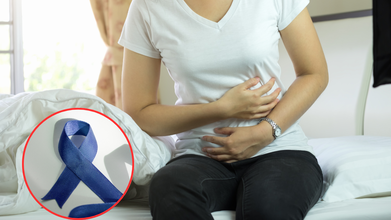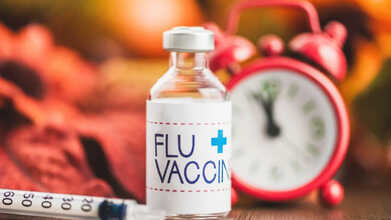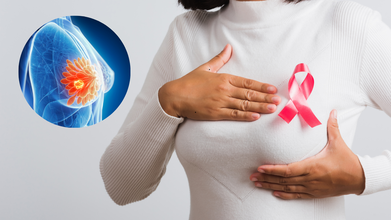- Health Conditions A-Z
- Health & Wellness
- Nutrition
- Fitness
- Health News
- Ayurveda
- Videos
- Medicine A-Z
- Parenting
- Web Stories
4 Early Signs of Colon Cancer You Cannot Ignore, According To Doctor 'See Doctor Soon'

(Credit-Canva)
Bowel cancer, also called colon or rectal cancer, is one of the most common cancers. It is the fourth most common cancer in the United States, and around 150,000 Americans are diagnosed with colorectal cancer every year, according to the Colorectal Cancer Alliance.
The time it's found makes a huge difference in how well a person does. Catching the disease early makes a huge difference in survival.
If the cancer is caught in the very first stage (Stage One), people have a 90% chance of living for five years or more. That's excellent odds. But if it's found much later (Stage Four), the chance of living five years or more drops to only 10%. The lesson is clear: early checking and spotting symptoms can save lives.
Key Early Warning Signs of Colon Cancer
A doctor known as "Dr. Ben", also known as Medicina y Mente online has highlighted four main signs that could point to early bowel cancer. He stressed that if you see these, you should go to your doctor as soon as possible, especially since some of these symptoms only show up when you use the toilet. Here are the four key things to look out for:
Blood in your stool: This is one of the most common early alarms.
Changes in how you go to the toilet: This doesn't mean just one bad day. It means a big difference in your normal habits, such as going from being constipated (having hard, difficult-to-pass stool) to suddenly having diarrhea.
Losing a lot of weight for no reason: If you lose a significant amount of weight without changing how you eat or how much you exercise, it is a concern.
Feeling extremely tired (fatigue): This is tiredness that doesn't go away, even after rest. This is only a worry if there's no other clear reason for the tiredness.
What Are Some Other Symptoms Of Colon Cancer?
It's natural to feel shy, but the NHS strongly advises people to see a doctor if they have been experiencing any symptoms of bowel cancer for three weeks or longer. Doctors and nurses talk about these things all the time, so please don't be embarrassed. Other symptoms of colon cancer that the NHS mentions include:
- Bleeding from your bottom.
- The constant feeling like you need to go to the toilet, even if you just went.
- Pain in your tummy (abdomen).
- Feeling a lump in your tummy.
- Feeling bloated
- Feeling short of breath.
If your stool is very black or dark red, or you have bloody diarrhea, you need to call 111 or get an urgent appointment with your GP. While these symptoms don't always mean cancer, it is very important to get checked to find out what the problem is.
How To Prevent Colon Cancer?
The best defense against bowel cancer is screening. The NHS offers home testing kits for everyone between the ages of 50 and 74.
These home tests can be analyzed to look for tiny signs of cancer even before you feel sick or notice any symptoms. This is the most effective way to catch cancer at the earliest, most treatable stage.
Think You Don’t Need A Flu Shot? Here’s Who Needs It And Why

Credits: Canva
Flu Shot: With flu season fast approaching, many people wonder when the best time is to get vaccinated. According to the U.S. Centers for Disease Control and Prevention (CDC), for most people who only need one dose, September and October are the ideal months to get the flu shot. The agency recommends that everyone be vaccinated by the end of October. Still, a percentage of the population believes flu shots aren’t essential and can be skipped.
Who Should Get a Flu Shot Every Year?
The CDC and major medical organizations advise everyone aged six months and older to get a yearly flu vaccination. Despite misinformation circulating online, these recommendations have not changed.
Certain groups are at higher risk of severe illness, people over 65, pregnant women, young children, and those with chronic health conditions like asthma, diabetes, heart disease, or weakened immune systems. While about 71% of seniors get their flu shot each year, less than half of other adults do. In children, vaccination rates have declined in recent years, with fewer than 50% receiving the vaccine last year.
Flu Shot: Why Flu Vaccines Matter
Flu vaccines may not prevent every infection, but they are highly effective at reducing severe illness and hospitalizations, says Dr. Sean O’Leary of the American Academy of Pediatrics. Tens of thousands of Americans die from the flu annually. During last year’s severe season, 280 children died from flu-related complications, nearly half of whom had no prior health issues, and most had not been vaccinated.
A rare but serious complication from last season was brain inflammation, which can cause seizures, hallucinations, or even death. Most affected children were unvaccinated.
Flu Shots During Pregnancy Offer Dual Protection
Pregnant women need to be especially cautious. A severe flu infection can lead to hospitalization or even preterm birth. Vaccination protects both mother and baby, since infants too young for their own vaccines benefit from the mother’s antibodies. Research shows flu shots are safe and effective during pregnancy.
Flu Shot: Choosing the Right Vaccine
For adults 65 and older, high-dose flu shots or vaccines with immune boosters are recommended, though a standard flu shot is also effective if those options are not available.
Flu Shot: Cost and Insurance Coverage
Flu shots are generally free under Medicare, Medicaid, and most private insurance plans if administered through in-network providers. Local health departments may also offer low-cost or free vaccines. The at-home FluMist option may require a delivery fee, though insurance should cover the vaccine itself.
Getting a Flu Shot Alongside COVID-19 Vaccine
It is safe to get both the flu and COVID-19 vaccines at the same time. Dr. Philip Huang, director of Dallas Health and Human Services, says this is a convenient way to stay protected. However, availability of COVID-19 vaccines for children may be limited, as federal recommendations have shifted and parents are encouraged to make personal decisions.
Unique Symptoms Of The Norovirus Behind The Royal Caribbean Cruise Outbreak

Credits: Canva
Norovirus outbreak cruise ship: The Centers for Disease Control and Prevention (CDC) confirmed that almost 100 passengers became ill during a 13-day Royal Caribbean cruise, according to NBC Miami on Thursday, October 2, 2025. The ship, Serenade of the Seas, departed from San Diego on September 19, 2025 and docked at the Port of Miami after the outbreak was reported to the CDC’s Vessel Sanitation Program. Passengers who fell sick began experiencing several notable symptoms, which we break down below.
Cruise Ship Norovirus Outbreak: Norovirus Hits the Cruise Ship
The CDC reported that 94 of 1,874 passengers and 4 of 883 crew members fell ill during the voyage, with the most common symptoms being diarrhea and vomiting. Passenger Bob Pettit, 87, shared his experience: “It really hits you hard, violently. I’ve been on twenty-five cruises, and this is the first time I’ve been this sick in my life.”
What Is Norovirus?
Often called the “stomach flu” or “stomach bug,” norovirus is not related to influenza. It causes acute gastroenteritis, an inflammation of the stomach and intestines. Most people recover within 1 to 3 days, but the virus can still be contagious for several days afterward. In 2025 alone, the CDC has recorded 19 gastrointestinal outbreaks on cruise ships, 14 of which were caused by norovirus. The CDC notes that such illnesses spread quickly in enclosed environments like cruise ships.
Norovirus outbreak cruise ship: Unique Symptoms Observed on This Cruise
Norovirus symptoms usually appear 12 to 48 hours after exposure. While diarrhea, vomiting, nausea, and stomach cramps remain common, this outbreak has shown some unusual signs:
- Dehydration
- Reduced urination
- Dry mouth and throat
- Feeling dizzy when standing
- Crying with few or no tears
- Unusual sleepiness or irritability
Norovirus: Who Is Most at Risk?
According to the CDC, anyone can contract norovirus, but some groups are more vulnerable. Young children, older adults, and people with weakened immune systems may experience more severe symptoms. Genetics may also play a role in susceptibility. Eating raw shellfish, such as oysters, can also increase the risk, as they may contain harmful viruses or bacteria.
How Long Does Norovirus Last?
Symptoms typically last 1 to 3 days and generally improve with rest and hydration. However, people remain contagious for at least 48 hours after symptoms stop, and children with diaper rash may shed the virus for up to 7 days. Seek medical care if severe dehydration develops or if symptoms persist beyond a few days.
How Long Is Norovirus Contagious?
According to CDC, Norovirus spreads very easily, starting from the moment symptoms appear and continuing for at least three days after recovery, and sometimes up to two weeks. Even after symptoms disappear, the virus can still be passed to others for several weeks, and in some cases, people may carry and shed the virus for months.
Can Wearing Black Undergarments Cause Breast Cancer? Expert Busts Breast Cancer-Related Myths

Credits: Canva
October is the Breast Cancer Awareness Month. Each year, the World Health Organization (WHO) observes this month to spread awareness on breast cancer and the month is also globally observed. This year, the theme is 'Every Story is Unique, Every Journey Matters'. The aim of this theme is to make more people understand that while community support is important, not everyone's journey can be the same. Each breast cancer diagnosis is personal.
Breast Cancer Statistics
Breast cancer is the most commonly diagnosed cancer among women worldwide. In 2022, approximately 2.3 million women were diagnosed and another 670,000 died from the disease, notes WHO.
WHO also notes that while the 5-year survival rates in high-income countries exceeds 90%, the figures drop to 66% in India and 40% in South Africa. These disparities are driven by unequal access to early detection, timely diagnosis and effective treatment. If the current trend continues, the incidence and mortality are projected to rise by 40% by 2050 hence the need for urgent and coordinated action. Indeed, where a woman lives should not determine whether she survives.
Established in 2021, the WHO Global Breast Cancer Initiative together with partners is working with countries to reduce breast cancer mortality by strengthening health systems.
The goal for this year's Breast Cancer Awareness Month thus would be to increase awareness and promote behavior change for early detection of the same.
One also must understand that the stigma and myths around breast cancer is what makes it difficult for people to understand what is happening with their body.
While the percentage of breast cancer patients is high in women, it is wrong to assume that men are not affected. Dr Mickey Mehta, previously told Health and Me, "Traditionally it is viewed as a women’s health issue, breast cancer awareness has often excluded men, even though they can also be affected by the disease. Engaging men in breast cancer awareness is crucial, as breast cancer can affect men, albeit at lower rates than women."
What Are Other Myths Associated With Breast Cancer?
Wearing A Bra Causes Breast Cancer
This idea was fueled by the 1995 book called Dressed to Kill by Sydney Ross Singer and Some Grismaijer which claimed that women who wear underwire bras for 12 hours a day have a much higher risk of developing breast cancer. The book claims that it restricts the lymph system, which can result in a build-up of toxins in the breasts. However, there is no credible research that shows a link between the two.
Dr Namrata Singal Sawant, Director and Senior Breast & Women's Imaging Consultant Radiologist at Vcare Imaging Diagnostic Centre, Mumbai, says, "While many of my patients ask me this question, especially about underwired bras or black bras; there has been no scientific evidence to claim the same. Although ill-fitting bras do cause chest pain or breast pain sometimes if too tight. But not cancer."
Sugar Consumption Can Caused Increased Risk of Breast Cancer
"It might be associated with many other health issues but has not been associated with breast cancer yet. However, keeping the sugar levels under control is very important for health healing of any breast infections or inflammatory disorders. Diabetic mastopathy is an important mimicker of breast cancer on imaging," says the doctor.
Wearing Black-dyed Clothes Can Cause Breast Cancer
The doctor says that it has not been proven by any scientific studies; however, wearing clothes with natural fibres and maintaining personal hygiene in the form of cleaning ourselves and our clothes regularly is a must.
Pregnancy Increases The Risk of Breast Cancer
As per the National Cancer Institute, the older a woman is when she has her first full-term pregnancy, the higher her risk of breast cancer. "Having our conventional reproductive customs like a first child before the age of 30 years and breastfeeding has been known to be associated with lower risks," says Dr Namrata. She also highlights the reports of Hormonal replacement therapy associated with increased risk of breast cancer.
Therefore, pregnancy does not increase the risk of breast cancer.
Breast Cancer Cannot Happen Again
"Well! Some types of breast cancer when diagnosed early have excellent prognosis to treatment. Whereas there are others especially “Triple-negative types” which are notorious for poor prognosis and recurrence. If the cancer is diagnosed late, or positive margins have been left behind during breast conservative treatment or some kind of treatment failure, there are definite chances of recurrence," explained the doctor.
© 2024 Bennett, Coleman & Company Limited

